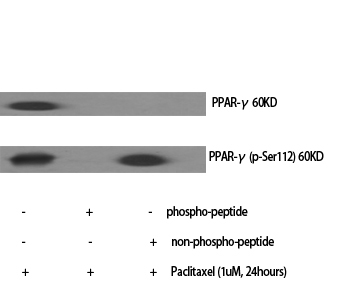PPAR-γ (phospho Ser112) Polyclonal Antibody
- Catalog No.:YP0316
- Applications:WB;ELISA
- Reactivity:Human;Mouse;Rat
- Target:
- PPAR-γ
- Fields:
- >>PPAR signaling pathway;>>AMPK signaling pathway;>>Longevity regulating pathway;>>Osteoclast differentiation;>>Thermogenesis;>>Non-alcoholic fatty liver disease;>>Huntington disease;>>Pathways in cancer;>>Transcriptional misregulation in cancer;>>Thyroid cancer;>>Lipid and atherosclerosis
- Gene Name:
- PPARG
- Protein Name:
- Peroxisome proliferator-activated receptor gamma
- Human Gene Id:
- 5468
- Human Swiss Prot No:
- P37231
- Mouse Gene Id:
- 19016
- Mouse Swiss Prot No:
- P37238
- Rat Gene Id:
- 25664
- Rat Swiss Prot No:
- O88275
- Immunogen:
- The antiserum was produced against synthesized peptide derived from human PPAR-gamma around the phosphorylation site of Ser112. AA range:78-127
- Specificity:
- Phospho-PPAR-γ (S112) Polyclonal Antibody detects endogenous levels of PPAR-γ protein only when phosphorylated at S112.
- Formulation:
- Liquid in PBS containing 50% glycerol, 0.5% BSA and 0.02% sodium azide.
- Source:
- Polyclonal, Rabbit,IgG
- Dilution:
- WB 1:500 - 1:2000. ELISA: 1:10000. Not yet tested in other applications.
- Purification:
- The antibody was affinity-purified from rabbit antiserum by affinity-chromatography using epitope-specific immunogen.
- Concentration:
- 1 mg/ml
- Storage Stability:
- -15°C to -25°C/1 year(Do not lower than -25°C)
- Other Name:
- PPARG;NR1C3;Peroxisome proliferator-activated receptor gamma;PPAR-gamma;Nuclear receptor subfamily 1 group C member 3
- Observed Band(KD):
- 60kD
- Background:
- peroxisome proliferator activated receptor gamma(PPARG) Homo sapiens This gene encodes a member of the peroxisome proliferator-activated receptor (PPAR) subfamily of nuclear receptors. PPARs form heterodimers with retinoid X receptors (RXRs) and these heterodimers regulate transcription of various genes. Three subtypes of PPARs are known: PPAR-alpha, PPAR-delta, and PPAR-gamma. The protein encoded by this gene is PPAR-gamma and is a regulator of adipocyte differentiation. Additionally, PPAR-gamma has been implicated in the pathology of numerous diseases including obesity, diabetes, atherosclerosis and cancer. Alternatively spliced transcript variants that encode different isoforms have been described. [provided by RefSeq, Jul 2008],
- Function:
- alternative products:Additional isoforms seem to exist,disease:Defects in PPARG are the cause of familial partial lipodystrophy type 3 (FPLD3) [MIM:604367]. Familial partial lipodystrophies (FPLD) are a heterogeneous group of genetic disorders characterized by marked loss of subcutaneous (sc) fat from the extremities. Affected individuals show an increased preponderance of insulin resistance, diabetes mellitus and dyslipidemia.,disease:Defects in PPARG can lead to type 2 insulin-resistant diabetes and hyptertension.,disease:Defects in PPARG may be associated with colon cancer.,disease:Defects in PPARG may be associated with susceptibility to obesity [MIM:601665].,disease:Variation in PPARG is associated with carotid intimal medial thickness 1 (CIMT1) [MIM:609338]. CIMT is a measure of atherosclerosis that is independently associated with traditional atherosclerotic cardiovascular disease
- Subcellular Location:
- Nucleus. Cytoplasm. Redistributed from the nucleus to the cytosol through a MAP2K1/MEK1-dependent manner. NOCT enhances its nuclear translocation.
- Expression:
- Highest expression in adipose tissue. Lower in skeletal muscle, spleen, heart and liver. Also detectable in placenta, lung and ovary.
- June 19-2018
- WESTERN IMMUNOBLOTTING PROTOCOL
- June 19-2018
- IMMUNOHISTOCHEMISTRY-PARAFFIN PROTOCOL
- June 19-2018
- IMMUNOFLUORESCENCE PROTOCOL
- September 08-2020
- FLOW-CYTOMEYRT-PROTOCOL
- May 20-2022
- Cell-Based ELISA│解您多样本WB检测之困扰
- July 13-2018
- CELL-BASED-ELISA-PROTOCOL-FOR-ACETYL-PROTEIN
- July 13-2018
- CELL-BASED-ELISA-PROTOCOL-FOR-PHOSPHO-PROTEIN
- July 13-2018
- Antibody-FAQs
- Products Images

- Western Blot analysis of various cells using Phospho-PPAR-γ (S112) Polyclonal Antibody diluted at 1:500
.jpg)
- Western Blot analysis of PC-3 cells using Phospho-PPAR-γ (S112) Polyclonal Antibody diluted at 1:500

